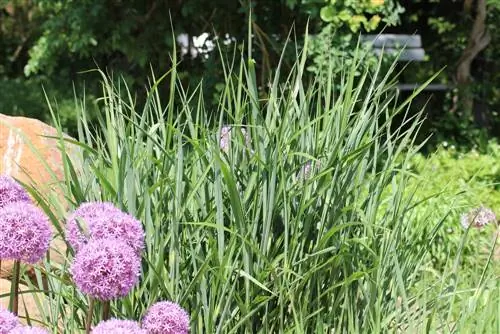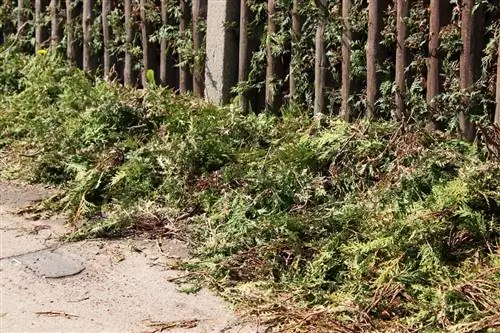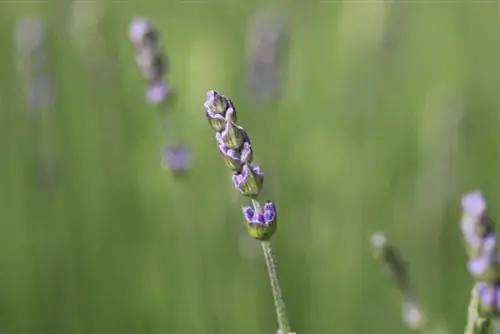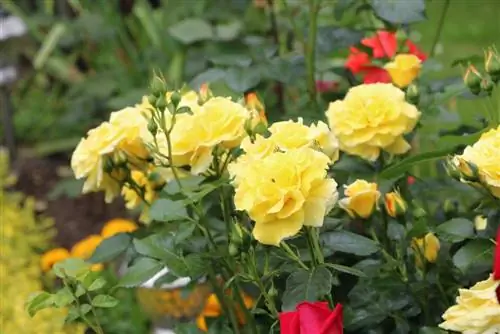- Author admin [email protected].
- Public 2023-12-17 03:39.
- Last modified 2025-06-01 06:48.
Miscanthus only demonstrates its robust winter hardiness of up to -23.3 degrees Celsius when the strong stalks protect the heart of the plant from moisture. The majestic leaves and sturdy stalks fulfill this task from autumn to spring until the fresh stalks sprout. During this time, nutrients are transferred from the leaves to the roots in order to create reserves for the coming season. This process can be recognized by the colorful discoloration of the leaves.
When is the best time?
- Best time: in the month of March, well before budding begins
- Earliest date: after the last severe frost
- Latest date in winter-harsh mountain regions: in the month of May
When exactly you cut back the sweet grass depends largely on the winter hardiness zone of your region. As long as a combination of moisture and frost could affect the heart of the plant, leave the retracted leaves and stalks as a natural protective cover. However, you should not wait until the green tips of young blades of grass appear. A cut into the shoot leaves brown-colored wounds that do not regenerate.
Tip:
In autumn, tie the stalks of fine-stemmed varieties, such as Miscanthus sinensis 'Gracillimus', into a loose bunch. Thanks to this measure, the moisture-sensitive heart of the plant is protected from rain and snow. This precaution is not necessary for vigorous species such as giant miscanthus or silver feather.
Pruning beneficial?
In the East Asian distribution areas, giant miscanthus and smaller conspecifics thrive vitally and he althily without human intervention. On the contrary, comprehensive, closed populations form in natural locations, primarily in national parks and other protected regions. The question is therefore obvious as to why pruning should be part of the care program at all. We have summarized the most important arguments for you here:
- Pruning creates space for fresh, juicy green shoots
- Without pruning, dead stalks fly uncontrollably through the garden
- Regular cutting keeps the urge to spread under control
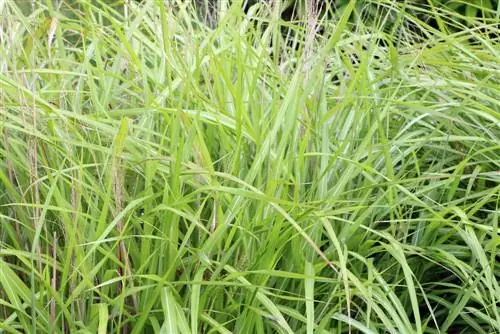
The invasive nature of Miscanthus is less pronounced than that of bamboo. Nevertheless, over the years, large clumps develop, the dominance of which is not always desirable in creative garden design. Cut back the stalks and ears consistently every year, thereby regulating the width growth.
Cutting miscanthus correctly: instructions
There are countless varieties with individual attributes for creative garden design. The spectrum ranges from delicate dwarf grass for pots to giant miscanthus as a privacy screen. The uncomplicated care program, which essentially consists of annual pruning, has contributed to the worldwide popularity of Miscanthus sinensis as an ornamental grass. The cutting procedure is the same for all varieties. How to do it right:
- Cut all stalks back to a height of 15 to 25 cm
- Grip the leaves in bunches and cut them off
- Collect plant parts that have fallen into the nest by hand
As a result of global warming, the grass is sometimes green earlier than expected. In this case, just cut the dead stalks back to just above the tips of the stalks. For next year, note an earlier time in your care plan to shorten your miscanthus close to the ground.
Note:
Did you know that miscanthus is a sought-after winter quarters for numerous beneficial insects in your garden. Therefore, before pruning, carefully examine the nest for small hibernating residents. If you find what you are looking for, postpone the appointment for a week or two.
Pruning in autumn
Under special circumstances, pruning in autumn can make sense. For example, if the mighty ornamental grass thrives on the edge of ponds and streams, autumn storms blow numerous blades onto the surface of the water. If home gardeners feel disturbed by the morbid appearance of withered grass, they like to use scissors as early as October or November.
In this context, it should be borne in mind that you are leaving the heart of the plant unprotected against the rigors of winter weather. To ensure that moisture in the clump does not cause rot, please spread a breathable fleece over the planting site after pruning. The edges are fixed with stones or staples so that the protective cover does not fly away.
Remove winter protection well before the start of the new growing season. Under normal weather conditions, fresh shoots will begin in April at the latest. In regions with mild winters, the fleece should give way at the end of February/beginning of March so as not to hinder the growth of the first stalk tips.
Tool
Don't let the uncomplicated cutting process lead you to underestimate the risk of injury when cutting back. The leaves of giant miscanthus and other large to medium-sized varieties have razor-sharp edges. The stalks can cut unprotected skin just as deeply as a freshly sharpened kitchen knife. The robust ornamental grasses easily resist conventional pruning shears, so the choice of cutting tool requires special attention. We have put together for you here what you can use to skillfully cut Miscanthus sinensis:
- Small varieties: Bypass secateurs
- Half-high to tall varieties: two-handed pruning shears
- Giant varieties: hedge trimmer or hand saw
- Gloves and long cuffs
- Safety glasses
- Spirit or alcohol
- Cloth

Despite its robust constitution, miscanthus is not immune to diseases and pests. Please disinfect the blades and saw blades before and after cutting. To do this, moisten a cloth with spirit or alcohol and wipe the cutting edges carefully.
Tip:
The sap of Miscanthus can cause phototoxic skin reactions in sensitive people. Under the influence of sunlight, an interaction occurs between the juice and human tissue. Therefore, please choose a day with cloudy skies for the pruning or protect your skin with gloves and long-sleeved clothing.
Reuse instead of throwing away
Miscanthus is causing a sensation worldwide as a prime example of a 'low-input plant'. This term describes the special property of Miscanthus to produce maximum yield with the lowest energy input. Added to this are the outstanding strength properties of the stems, which serve as a replacement for the plastic polystyrene in modern industry. Coupled with excellent absorbency, sweet grass is one of the most interesting plants for the future. You can also benefit from these attributes in your garden. Instead of carelessly disposing of the clippings in the compost, they are reused like this:
- Chop the stalks and use them as mulch in the bed
- As a straw replacement in strawberry cultivation for clean fruits
- A natural base for ripening pumpkins to protect against soil moisture
- Ideal as bedding in animal cages or horse boxes
- As a loosening additive for plant soil and pot substrate
The spikes of giant miscanthus act as stable supports in ornamental and kitchen gardens, for example for peas or beans. Ecologically oriented gardeners tie small bunches together and place them in a partially shaded, protected location as a natural insect hotel for free.
Comb out miscanthus dwarfs instead of cutting them off
- Instructions without scissors -
Specialist retailers offer delicate varieties for small gardens and cultivation in containers. The delicate grass heads of 'Gracillimus', 'Little Zebra' and other hybrids do not necessarily require pruning close to the ground, as these instructions recommend for their impressive counterparts. If you miss the perfect time to cut, simply comb out the dead ornamental grass with your hands. Wear sturdy gloves. Pull your hands repeatedly from bottom to top through the entire head, thinning out the ornamental grass without damaging the fresh shoots.

